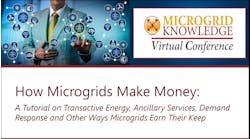A subsidiary of British utility Centrica is providing financial backing for LO3 Energy, the New York startup working on a carefully watched blockchain microgrid in Brooklyn.
The investment – amount undisclosed – comes as Centrica also collaborates with LO3 on two new projects, one with its subsidiary Direct Energy in the US, and another being explored in the UK.
“This is an important investment for Centrica Innovation,” said Christophe Defert, ventures director at Centrica Innovations. “We look forward to working with LO3 on blockchain-based projects more broadly across Centrica, and the opportunity to provide our customers with more flexibility and control over how they buy and use their energy.”
The Centrica/Direct Energy project in the US involves applications for commercial and industrial enterprises, and is already underway in stealth mode. The UK project is still in the discussion stage.
Braemar Energy Ventures, a venture capital fund for early- to mid-stage energy tech, also is contributing to the funding round for LO3.
“This opportunity represents the convergence of two macro trends that underpin Braemar’s investment thesis – the transition of global energy markets to more decentralized, distributed systems and the development of platforms that will provide new forms of consumer participation,” said Jiong Ma, partner at Braemar Energy Ventures.
Separately, Siemens last year began collaborating with LO3 Energy on the Brooklyn blockchain microgrid. The new partnership marked the first time that LO3’s blockchain technology will be integrated with a Siemens microgrid controller.
LO3 is focusing on commercializing its blockchain-based platform, which stores and validates data so that consumers can generate, store, buy and sell energy through tamper-proof transactions that can be tracked and need no external monitoring.
“This investment not only allows us to scale our platform to demonstrate the power of the blockchain to customers worldwide, but also shows that a strategic player has a similar vision of the future of energy,” said Lawrence Orsini, LO3 founder and CEO.
LO3 also is working on blockchain microgrids in Australia.
Track news about blockchain microgrids. Subscribe to the free Microgrid Knowledge newsletter.






